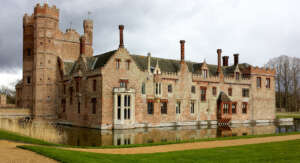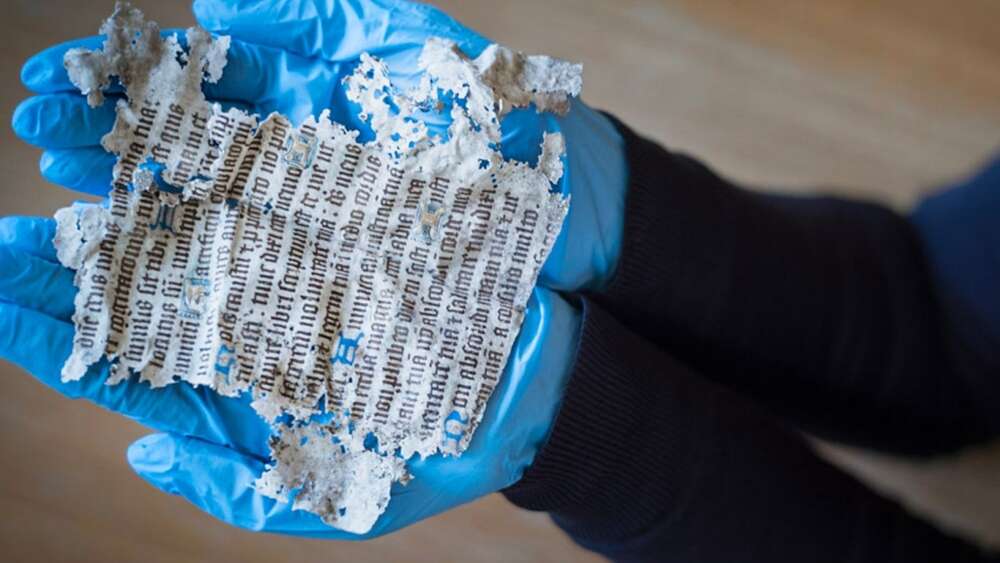Underfloor archeology haul reveals devout Catholic family who were persecuted for their faith
An underfloor archeology haul has been discovered by an English archaeologist who patiently worked alone through the country’s lockdown. His “star find” is a stunning, 15th-century fragment of Psalm 39, accented with gold leaf and bright blue ink.
But it is what the discovery tells us about the family who owned the house that makes the finding so fascinating.
 Oxburgh Hall was built after 1476, when Sir Edmund Bedingfeld inherited the estate. And it looks exactly as you might imagine – a stately manor house, complete with moat. The family still live in part of the building today.
Oxburgh Hall was built after 1476, when Sir Edmund Bedingfeld inherited the estate. And it looks exactly as you might imagine – a stately manor house, complete with moat. The family still live in part of the building today.
It is currently under the care of the UK’s National Trust and – until COVID – was in the process of being carefully re-roofed in a project that included lifting many of the floorboards in the attic rooms to repair floor joists.
When COVID hit, independent archaeologist Matt Champion agreed to continue the work through lockdown on his own. He was carrying out a careful fingertip search when his diligence was rewarded with a staggering find of underfloor items that had remained undisturbed for centuries.
A page from a rare 15th-century illuminated manuscript was among the items recovered, many of which dated back to the Tudor period. There were also fragments of late-16th century books and high-status Elizabethan textiles. Plus there were some more modern items, like cigarette packets and an empty box of Terry’s chocolates that date to the Second World War – perhaps a reminder that even people who live in big fancy houses with moats have a tendency to hide the evidence of their indulgences.
But it’s the story of the home’s owners that is most interesting.
According to the UK’s National Trust records, Bedingfield was “a rising star” of the Tudor royal court, who was knighted and received a visit from the King and Queen. For 100 years, the family were held in high esteem, with their support for Catholic Mary I’s claim to the throne bringing them significant status and power.
But that all changed in 1559 when, following the succession of Elizabeth I, Sir Henry Bedingfeld refused to sign the Act of Uniformity.
The Act outlawed Catholic Mass, forcing those who wished to receive this rite legally to attend an Anglican parish church. Refusing to conform was a dangerous act and Catholic priests were routinely tried and executed. And giving shelter to Catholic priests was an offence punishable by imprisonment.
As a result, Catholic families like the Bedingfelds were forced to conceal their worship in their homes, so they began building secret chapels and ‘priest holes’.
The Bedingfelds’ refusal to change their faith after the Reformation not only affected their status, but also their finances. For 300 years, the family were subjected to heavy taxation, exclusion from public office and education.
Given the family and house’s history, it’s no wonder that UK historians are so excited by the lockdown finds at Oxburgh Hall.
“These objects contain so many clues which confirm the history of the house as the retreat of a devout Catholic family, who retained their faith across the centuries.” – Russell Clement, General Manager at Oxburgh Hall
The manuscript parchment and other objects found may well have been used in illegal masses and were hidden deliberately by the family. Handwritten music scraps from the 16th century have been identified as from a cantus or soprano part, and may have been used as part of the secret masses historians already know took place at the house.
The most striking discovery was made by a builder who found a complete book called the King’s Psalms, dated 1568, in an attic void. Complete with its gilded leather binding, it is almost intact – a few fragments from it had previously been found in a rats’ nest.
Despite its age, the gold leaf and bright blue of the illuminated initials are still in vibrant condition.
“These portable prayer books were for private devotion.” – Anna Forest, National Trust curator
“The text is distinct enough for us to identify it as part of the Latin Vulgate Psalm 39 (“Expectans expectaui”). We contacted Dr James Freeman, medieval manuscripts specialist at Cambridge University Library, who explained that the leaf may be from a Psalter, but its small size – just 8cm x 13cm – suggest it once was part of a Book of Hours. These portable prayer books were for private devotion,” said Anna Forest, the National Trust curator who is overseeing the work.
“The use of blue and gold for the minor initials, rather than the more standard blue and red, shows this would have been quite an expensive book to produce. It is tantalising to think that this could be a remnant of a splendid manuscript and we can’t help but wonder if it belonged to Sir Edmund Bedingfeld, the builder of Oxburgh Hall,” she said.
Russell Clement, General Manager at Oxburgh Hall, explained that the underfloor finds had exceeded the hopes of everyone involved in the project.
“We had hoped to learn more of the history of the house during the re-roofing work and have commissioned paint analysis, wallpaper research, and building and historic graffiti recording. But these finds are far beyond anything we expected to see,” Clement said.
“These objects contain so many clues which confirm the history of the house as the retreat of a devout Catholic family, who retained their faith across the centuries. We will be telling the story of the family and these finds in the house, now we have reopened again following lockdown.”
Email This Story
Why not send this to a friend?



